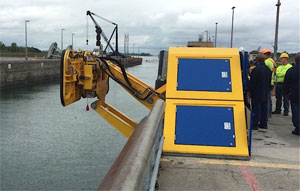Hands-free mooring (HFM) technology, which uses vacuum pads instead of lines to hold ships in place as they transit locks, is now fully deployed throughout the St. Lawrence Seaway.
In a June 6 announcement, the U.S. Department of Transportation’s Saint Lawrence Seaway Development Corp. (SLSDC) called HFM the most important technological advance on the Seaway since it opened in 1959.
The vacuum pads each provide up to 20 tons of holding force. They are mounted on vertical rails inside the lock chamber wall to secure a ship as it is raised or lowered, keeping it a fixed distance from the wall. The last step in the lockage operation consists of releasing the vacuum and retracting the pads so that the vessel can sail safely out of the lock.
“Hands-free mooring will dramatically improve the vessel transit experience through the Seaway by enhancing safety and achieving greater efficiencies in freight movement,” said SLSDC Deputy Administrator Craig Middlebrook.
The agency invested $23 million to install HFM at the Snell Lock and Eisenhower Lock. The project marked the first use of the technology on an inland waterway, according to the SLSDC, which said it has prepared its workforce with the skills necessary to implement the system.
“This new technology is a significant modernization of the St. Lawrence Seaway’s infrastructure, and will enhance workplace safety, lower operating costs for carriers and decrease vessel transit times through the locks,” said Transportation Secretary Elaine Chao.
The SLSDC said full implementation of the HFM system was important to the future of the Seaway. Last year, there was a 7 percent increase in the number of vessels transiting the U.S.-Canadian waterway. They moved 41 million tons of cargo, the most since 2007.
On the northern side of the border, the St. Lawrence Seaway Management Corp. (SLSMC) marked its 60th anniversary with the opening of the 2019 navigation season on March 26. The season’s first ship, the 650-foot bulk carrier Federal Kumano, loaded with titanium chloride, used HFM technology as it transited the St. Lambert Lock on its way to the Port of Ashtabula, Ohio.
Andrew Bogora, spokesman for the SLSMC, said nine to 12 ships typically navigate each Seaway lock per day. Given that 13 locks are equipped with HFM, “we can estimate (the system) processes between 117 and 156 lock transits per day,” he said. The Iroquois Lock and Welland Canal Lock 8 are “low lift” locks and are not equipped with the technology.
Bogora said HFM can reduce lock transits by up to seven minutes, with the potential for time savings varying per lock. He said he was unaware of any problems with the implementation of the system.
The St. Lawrence Seaway begins in Montreal and extends west, connecting the lower St. Lawrence River to the Great Lakes. The Seaway’s 15 locks (13 Canadian and two American) enable ships to climb 551 feet from sea level up to Lake Erie.
During the past 60 years, ships have transported almost 3 billion metric tons of cargo while completing over 340,000 transits of Seaway locks.

